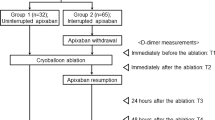Abstract
Background
Aggressive anticoagulation with heparin to maintain an activated clotting time (ACT) >300 s is required during catheter ablation of atrial fibrillation (AF) to reduce the risk of systemic thromboembolism. The purpose of this study is to describe the incidence and outcome of protamine reactions and analyze the risk factors in patients undergoing catheter ablation of AF.
Methods
The patient population included 242 consecutive patients (193 men, age 57.6 ± 10.8 years) with drug refractory AF who underwent catheter ablation and received protamine immediately following catheter ablation to reverse the effects of heparin. Fifty eight of these patients had prior exposure to protamine.
Results
Three of the 242 patients in our study developed an adverse reaction to protamine (1.2%). Although each of the three protamine reaction presented in a dramatic fashion with profound hypotension, all three patients responded to medical treatment and did not experience clinical sequelae. Age, gender, type of AF, number of ablations, prior exposure, diabetes mellitus, and ejection fraction did not predict the occurrence of these reactions.
Conclusion
This study reports, for the first time, the incidence and outcomes of protamine reaction in patients undergoing catheter ablation of AF. The results of this study reveal that protamine reactions present in a dramatic fashion often with profound hypotension. Although the incidence of protamine reactions in this setting is low (1.2%), they do occur. Electrophysiologists who use protamine need to be aware of this reaction and the appropriate therapeutic interventions.
Similar content being viewed by others
References
Calkins, H., Brugada, J., Packer, D. L., Cappato, R., Chen, S. A., Crijns, H. J., et al. (2007). HRS/EHRA/ECAS expert consensus statement on catheter and surgical ablation of atrial fibrillation: recommendations for personnel, policy, procedures and follow-up. Heart Rhythm, 4, 816–861.
Cheema, A., Dong, J., Dalal, D., Marine, J. E., Henrikson, C. A., Spragg, D., et al. (2007). Incidence and time course of early recovery of pulmonary vein conduction after catheter ablation of atrial fibrillation. Journal of Cardiovascular Electrophysiology, 18(4), 387–391.
Patel, A. A., Clyne, C. A., Henyan, N. N., White, C. M., Zembrowski, B. F., Migeed, M., et al. (2007). The use of protamine after radiofrequency catheter ablation: a pilot study. Journal of Interventional Cardiac Electrophysiology, 18(2), 155–158.
Horrow, J. C. (1985). Protamine: a review of its toxicity. Anesthesia and Analgesia, 64(3), 348–361.
Shapira, N., Schaff, H. V., Piehler, J. M., White, R. D., Still, J. C., & Pluth, J. R. (1982). Cardiovascular effects of protamine sulfate in man. The Journal of Thoracic and Cardiovascular Surgery, 84(4), 505–514.
Porsche, R., & Brenner, Z. R. (1999). Allergy to protamine sulfate. Heart & Lung, 28(6), 418–428.
Levy, J. H., & Adkinson Jr., N. F. (2008). Anaphylaxis during cardiac surgery: implications for clinicians. Anesthesia and Analgesia, 106(2), 392–403.
Nordström, L., Fletcher, R., & Pavek, K. (1978). Shock of anaphylactoid type induced by protamine: a continuous cardiorespiratory record. Acta Anaesthesiologica Scandinavica, 22(3), 195–201.
Panos, A., Orrit, X., Chevalley, C., & Kalangos, A. (2003). Dramatic post-cardiotomy outcome, due to severe anaphylactic reaction to protamine. European Journal of Cardio-Thoracic Surgery, 24(2), 325–327.
Weiler, J. M., Gellhaus, M. A., Carter, J. G., Meng, R. L., Benson, P. M., Hottel, R. A., et al. (1990). A prospective study of the risk of an immediate adverse reaction to protamine sulfate during cardiopulmonary bypass surgery. The Journal of Allergy and Clinical Immunology, 85(4), 713–719.
Kimmel, S. E., Sekers, M. A., Berlin, J. A., Ellison, N., DiSesa, V. J., & Strom, B. L. (1998). Risk factors for clinically important adverse events after protamine administration following cardiopulmonary bypass. Journal of the American College of Cardiology, 32(7), 1916–1922.
Weiler, J. M., Gellhaus, M. A., Carter, J. G., Meng, R. L., Benson, P. M., Hottel, R. A., et al. (1990). A prospective study of the risk of an immediate adverse reaction to protamine sulfate during cardiopulmonary bypass surgery. The Journal of Allergy and Clinical Immunology, 85(4), 713–719.
Gottschlich, G. M., Gravlee, G. P., & Georgitis, J. W. (1988). Adverse reactions to protamine sulfate during cardiac surgery in diabetic and non-diabetic patients. Annals of Allergy, 61(4), 277–281.
Levy, J. H., Schwieger, I. M., Zaidan, J. R., Faraj, B. A., & Weintraub, W. S. (1989). Evaluation of patients at risk for protamine reactions. The Journal of Thoracic and Cardiovascular Surgery, 98(2), 200–204.
Just-Viera, J. O., Fischer, C. R., Gago, O., & Morris, J. D. (1984). Acute reaction to protamine. Its importance to surgeons. The American Surgeon, 50(1), 52–60.
Stewart, W. J., McSweeney, S. M., Kellett, M. A., Faxon, D. P., & Ryan, T. J. (1984). Increased risk of severe protamine reactions in NPH insulin-dependent diabetics undergoing cardiac catheterization. Circulation, 70(5), 788–792.
Reed, D. C., & Gascho, J. A. (1988). The safety of protamine sulfate in diabetics undergoing cardiac catheterization. Catheterization and Cardiovascular Diagnosis, 14(1), 19–23.
Vincent, G. M., Janowski, M., & Menlove, R. (1991). Protamine allergy reactions during cardiac catheterization and cardiac surgery: risk in patients taking protamine-insulin preparations. Catheterization and Cardiovascular Diagnosis, 23(3), 164–168.
Joint Task Force on Practice Parameters; American Academy of Allergy, Asthma and Immunology American College of Allergy, Asthma and Immunology; Joint Council of Allergy, Asthma (2005). The diagnosis and management of anaphylaxis: an updated practice parameter. The Journal of Allergy and Clinical Immunology, 115(3, supplement 2), S483–S523.
Author information
Authors and Affiliations
Corresponding author
Additional information
Disclosures
No potential conflicts of interest arise from the publication of this manuscript.
Dr. Chilukuri was supported by The Norbert and Louise Grunwald Cardiac Arrhythmia Research Fund. Dr. Scherr was supported by the FWF—Austrian Science Fund.
Rights and permissions
About this article
Cite this article
Chilukuri, K., Henrikson, C.A., Dalal, D. et al. Incidence and outcomes of protamine reactions in patients undergoing catheter ablation of atrial fibrillation. J Interv Card Electrophysiol 25, 175–181 (2009). https://doi.org/10.1007/s10840-009-9364-0
Received:
Accepted:
Published:
Issue Date:
DOI: https://doi.org/10.1007/s10840-009-9364-0




